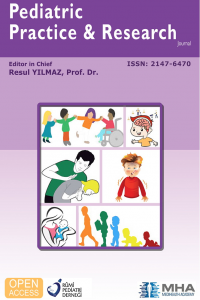Epikardiyal Kalp Pili Takılmış Klinik Olarak Normal Bir Çocukta Holter Monitörizasyonun Önemi
Epikardiyal Kalp Pili Takılmış Klinik Olarak Normal Bir Çocukta Holter Monitörizasyonun Önemi
Arrhythmias in congenital heart diseases may be seen due to structural disorders or they may develop as a result of surgical interventions due to repair. The incidence of complete atrioventricular block after cardiac surgery for congenital heart disease was reported to be between 1-3%. Permanent pacemaker implantation may be required in some rhythm problems after open heart surgery. Here, we present a five-year-old boy who has been followed up regular intervals for three years in our outpatient clinic. When he was four-month-old, he had been undertaken congenital heart surgery in another centre and then permanent epicardial pacemaker implantation had been done due to development of complete atrioventricular block. Despite very little or no problems were seen in electrocardiographic evaluations, we determined serious rhythm problems (failure to capture, oversensing and also long pauses up to 5.5 seconds) via holter ECG monitoring performed with regular intervals. In the event of any significant change of setting or battery/lead change in the devices of patients with permanent pacemaker implantation, careful examination of the holter ECG monitoring is essential to avoid unexpected conditions.
___
- References 1- Khairy P. EP challenges in adult congenital heart disease. Heart Rhythm 2008;5(10):1464–72. 2- Midha D, Chen Z, Jones DG et al. All Pacing in congenital heart disease – A four-decade experience in a single tertiary centre. Int J Cardiol 2017;241:177–81. 3- Skippen PW, Sanatani S, Gow RM, Froese N. Diagnosis of postoperative arrhythmias following paediatric cardiac surgery. Anaesth Intensive Care 2009;37(5):705-19. 4- Karpuz D, Demetgül H, Giray D, Hallıoğlu O. Frequency and risk factors of arrhythmia developing after cardiac surgery in children. Mersin Univ Saglık Bilim Derg 2018;11(1):1-6. 5- Delaney JW, Moltedo JM, Dziura JD, Kopf GS, Snyder CS. Early postoperative arrhythmias after pediatric cardiac surgery. J Thorac Cardiovasc Surg 2006;131(6):1296‑300. 6- Kabbani MS, Al Taweel H, Kabbani N, Al Ghamdi S. Critical arrhythmia in postoperative cardiac children: Recognition and management. Avicenna J Med 2017;7(3):88-95. 7- Grosse-Wortmann L, Kreitz S, Grabitz RG et al. Prevalence of and risk factors for perioperative arrhythmias in neonates and children after cardiopulmonary by pass: continuous holter monitoring before and for three days after surgery. J Cardiothorac Surg 2010;5:85. Doi: 10.1186/1749-8090-5-85. 8- Bonatti V, Agnetti A, Squarcia U. Early and late postoperative complete heart block in pediatric patients submitted to open-heart surgery for congenital heart disease. Pediatr Med Chir 1998;20 (3):181-6. 9- Jaeger FJ, Trohman RG, Brener S, Loop F. Permanent pacing following repeat cardiac valve surgery. Am J Cardiol 1994;74(5):505-7. 10- Kron J, Herre J, Renfroe EG et al. Lead and device related complications in the Antiarrhytmics Versus Implantable Defibrillators Trial. Am Heart J 2001;141(1):92-8. 11- Israel CW. How to avoid inappropriate therapy. Curr Opin Cardiol 2008;23(1):65–71.
- ISSN: 2147-6470
- Başlangıç: 2013
- Yayıncı: MediHealth Academy Yayıncılık
Sayıdaki Diğer Makaleler
İslami İlimler Fakültesi Öğrencilerinin Kan Bağışına Yönelik Tutumları
Nejla CANBULAT ŞAHİNER, İrupec2019 IRUPEC2019, Yasemin ŞANLI
Hatice YILMAZ DAĞLI, Sevgi PEKCAN, İsmail REİSLİ, Sevgi KELEŞ
İrfan TAŞOĞLU, Dilek DİLLİ, Rumeysa ÇİTLİ
The Chıld Who Crıes When She Smıles: A Cephalıc Tetanus Case Presentatıon
